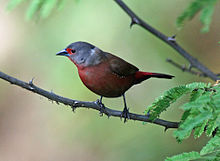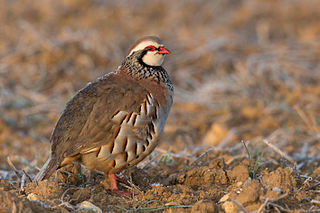
The red-legged partridge is a gamebird in the pheasant family Phasianidae of the order Galliformes, gallinaceous birds. It is sometimes known as French partridge, to distinguish it from the English or grey partridge. The genus name is from Ancient Greek alektoris a farmyard chicken, and rufa is Latin for red or rufous.

The brambling is a small passerine bird in the finch family Fringillidae. It has also been called the cock o' the north and the mountain finch. It is widespread and migratory, often seen in very large flocks.

The whiskered tern is a tern in the family Laridae. The genus name is from Ancient Greek khelidonios, "swallow-like", from khelidon, "swallow". The specific hybridus is Latin for hybrid; Peter Simon Pallas thought it might be a hybrid of white-winged black tern and common tern, writing "Sterna fissipes [Chlidonias leucopterus] et Hirundine [Sterna hirundo] natam”.

Rüppell's warbler is a typical warbler of the genus Curruca. It breeds in Greece, Turkey and neighbouring islands. It is migratory, wintering in northeast Africa. This is a rare vagrant to western Europe. The name is occasionally cited as "Rueppell's warbler".

The red-billed firefinch or Senegal firefinch is a small seed-eating bird in the family Estrildidae. This is a resident breeding bird in most of Sub-Saharan Africa with an estimated global extent of occurrence of 10,000,000 km2. It was introduced to Egypt, but the population there has become extinct. It was also introduced to southern Algeria where it is currently expanding northward.

Levaillant's woodpecker or Levaillant's green woodpecker, is a large African member of the woodpecker family Picidae.

The tiger shrike or thick-billed shrike is a small passerine bird which belongs to the genus Lanius in the shrike family, Laniidae. It is found in wooded habitats across eastern Asia. It is a shy, often solitary bird which is less conspicuous than most other shrikes. Like other shrikes it is predatory, feeding on small animals. Its nest is built in a tree and three to six eggs are laid.
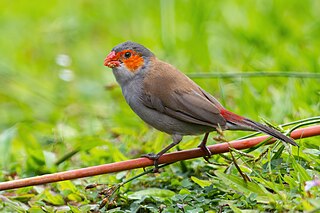
The common waxbill, also known as the St Helena waxbill, is a small passerine bird belonging to the estrildid finch family. It is native to sub-Saharan Africa but has been introduced to many other regions of the world and now has an estimated global extent of occurrence of 10,000,000 km2. It is popular and easy to keep in captivity.
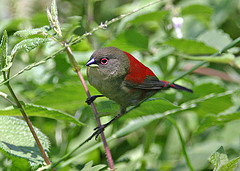
The Abyssinian crimsonwing, also known as the Ethiopian crimsonwing, Salvadori's crimsonwing or crimson-backed forest finch, is a common species of estrildid finch found in eastern Africa. It has an estimated global extent of occurrence of 190,000 km2 (73,000 sq mi).

The bar-breasted firefinch is a common species of estrildid finch found in western and central Africa. It has an estimated global extent of occurrence of 2,900,000 km².

The African firefinch, also called the dark firefinch or blue-billed firefinch due to the color of its bill, is a common species of estrildid finch found in almost all parts of Africa. It has an estimated global extent of occurrence of 5,400,000 km2 (2,100,000 sq mi).

The Landana firefinch, also known as the pale-billed firefinch, is a species of estrildid finch found in central Africa. It has an estimated global extent of occurrence of 100,000 km2. It occurs mainly in southern Gabon and the Republic of Congo; as well as in western Democratic Republic of the Congo and in extreme northwestern Angola. The IUCN has classified the species as being of least concern. Clements has lumped this bird into the African firefinch.
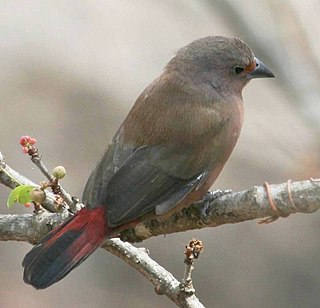
Jameson's firefinch is a common species of estrildid finch found in Sub-Saharan Africa. It has an estimated global extent of occurrence of 2,600,000 km2.

The rock firefinch is a species of estrildid finch found in the Jos Plateau of central Nigeria and in Cameroon. It has an estimated global extent of occurrence of 29,000 km2. The rock firefinch was discovered recently, in 1998. Rock firefinches fall in the family Estrildidae, which contains small passerine birds of the Old World and Australasia. Rock firefinches seem to be most closely related to Mali firefinches and Chad firefinches. The species name sanguinodorsalis means blood-red back, which was chosen because it describes the vibrant red back color of the male plumage. The status of the species is evaluated as Least Concern.
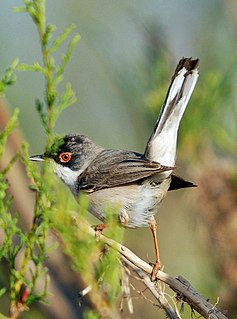
Menetries's warbler or Ménétries's warbler is a small passerine bird of Southwest Asia belonging to the genus Curruca. The name of the species commemorates Édouard Ménétries, the French zoologist who described the species in 1832. It is closely related to the Sardinian warbler of the Mediterranean basin and is similar to it in appearance.

Bennett's woodpecker is a species of bird in the family Picidae. It is found in woodlands and bushes in Africa. The International Union for Conservation of Nature (IUCN) has assessed it as a least-concern species.
The brown-headed apalis is a small passerine bird belonging to the genus Apalis in the family Cisticolidae. Formerly included within the grey apalis but is now commonly considered to be a separate species. It has two subspecies: A. a. alticola and A. a. dowsetti

The Bornean treepie is a passerine bird belonging to the treepies genus, Dendrocitta, of in the crow family, Corvidae. It is endemic to the island of Borneo. It is sometimes treated as a subspecies of the Sumatran treepie.
